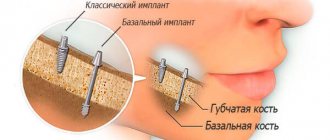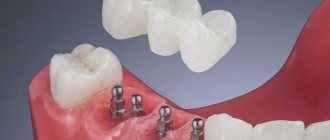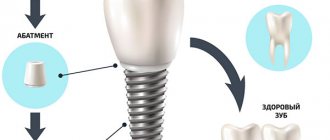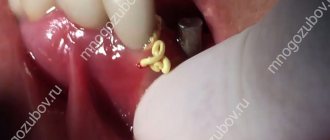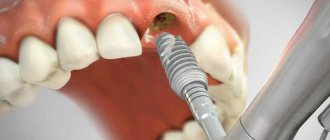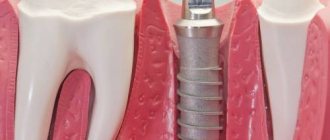One of the fastest methods of restoring a lost tooth is express implantation. The process of installing implants causes considerable anxiety and fear of the painful procedure for many people. In addition, it is generally accepted that this is a rather lengthy process that will require a lot of time and frequent visits to the doctor.
If we talk about classical implantation, then, of course, it will require a certain amount of time, but if you need to quickly install an implant that will hide the absence of one or more teeth, you can resort to express implantation.
The main differences between express implantation and classical methods
Modern technologies and techniques make it possible to make treatment and prosthetics procedures as painless as possible. If you have any problems or diseases, you should consult a doctor as soon as possible to prevent the development of pathologies.
Installation of implants using classical methods requires the presence of bone tissue, but its destruction is a fairly common situation in patients. In some cases, a bone grafting procedure may even be required. The duration of engraftment can be from six to eight months. After which it is already possible to introduce an implant, which will also require time for its engraftment to the bone tissue.
If no complications arise, a permanent crown is installed. Express dental implantation occurs much faster. Sometimes, if the patient does not have any diseases that prevent the operation, the entire procedure can be carried out in a short time, from 1 to 3 days. This is achieved through the use of specially designed mechanisms.
The entire procedure can be briefly described in the following steps:
- examination of the patient for the presence of diseases and the possibility of using the implantation method;
- Under local anesthesia, implants are implanted and impressions are taken;
- fitting and installation of manufactured metal-plastic structures.
The metal-plastic crowns used are installed as temporary elements. Some time after the operation, it is recommended to conduct a re-examination; if the healing process went well and no complications were identified, you can, if desired, replace it with more expensive crowns.
Indications
- If one or more teeth have been lost previously;
- if there is serious damage to the tooth and there is no way to restore it;
- if previous attempts have been made to treat the tooth, which were not successful and there is a need for its removal;
- if the patient has lost all teeth (complete edentia) and needs prosthetics of the entire dentition.
A prerequisite for such surgical intervention is the presence of a sufficient volume of jaw bone tissue.
Our team of doctors
Maxillofacial surgeon, Implantologist
Bocharov Maxim Viktorovich
Experience: 11 years
Dental surgeon, Implantologist
Chernov Dmitry Anatolievich
Experience: 29 years
Orthopedist, Neuromuscular dentist
Stepanov Andrey Vasilievich
Experience: 22 years
Endodontist, Therapist
Skalet Yana Alexandrovna
Experience: 22 years
Orthopedic dentist
Tsoi Sergey Konstantinovich
Experience: 19 years
Dentist-orthodontist
Enikeeva Anna Stanislavovna
Experience: 3 years
Single-stage implantation, immediately after removal. Immediate load
When the roots of the frontal teeth are damaged and cannot be restored, a one-step implantation method was developed immediately after root removal. With proper preliminary preparation for this operation, the entire process from the start of tooth extraction to the installation of a temporary crown will take about 40 minutes.
Immediately after tooth extraction, an implant with a temporary crown is installed in the socket - it is important to perform the removal very carefully, without damaging the periodontal tissue. After 2-4 months, when the artificial tooth root fuses with the bone tissue of the jaw, the temporary crown is replaced with a permanent ceramic crown, which will serve the person for many years. Another name for this method is immediate loading implantation. Immediate loading is usually not used on molars, which are chewing teeth numbered higher than 5.
One of the main advantages of one-stage implantation is minimal damage to the soft tissues of the jaw, which allows you to preserve the gingival papillae and the general contour of the gums and gives an excellent aesthetic result.
Artificial tooth roots installed using the express method, at the end of treatment, are not inferior in functionality and durability to implants installed using the classical method. Using this method, it is possible to restore both front and back teeth, with the difference that instead of a one-time load, immediate dentures are used to temporarily close the defect on the back ones.
Simultaneous implantation performed by experienced specialists minimizes the likelihood of damage to surrounding tissues, swelling and other complications.
Advantages of express dental implantation
One of the main advantages is the possibility of implantation without bone tissue augmentation. To do this, implants of the correct shape and size are selected. The implementation can be carried out in a minimally invasive way, i.e. by puncture method.
The installed elements are made in the form of a single structure, including the abutment and the implant body, which protrudes above the gum, so it is possible to immediately install a crown. Due to the integrity of the mechanism, the risk of microbial accumulation and inflammation is minimized.
The cost of express implantation in Moscow may vary in different clinics. When choosing a dental center, you should give preference not only to a more favorable cost, but also to pay attention to the choice of qualified specialists. The price of express implantation is not very different from classical methods, however, due to the reduction in the labor intensity of the process and the work of the doctor, it can sometimes be even cheaper.
Benefits of the operation
Dental restoration using the express method has a number of undeniable advantages:
- Save time.
- Comfortable operation with a minimum number of complications.
- Instant restoration of bone tissue.
- Does not affect the quality of life of patients - the diet remains virtually unchanged (only solid foods need to be excluded), you can fully talk and smile without experiencing aesthetic discomfort.
- Durability of dental implants due to strong fixation in the deep layers of bone.
- Saving money.
Dental implantation in one day in Moscow
Modern dentistry allows you to solve dental problems in the shortest possible time. Damage or loss of teeth, especially the front ones, brings considerable discomfort and suppresses self-confidence. I want to get rid of these problems as quickly as possible. Currently, it is possible to carry out the implantation procedure on the same day of treatment.
The Dental Studio clinic officially performs dental implantation in one day in Moscow. Implants can be installed immediately, without reducing the effectiveness of the procedure. The crown material is selected in such a way as to cause minimal discomfort to the patient. All implants are absolutely safe, certified, tested. The procedure is carried out by professionals. A guarantee is provided for the crowns.
As a rule, small implants are selected that can be quickly implanted into the gums. The duration of rehabilitation is minimal, and the load is transferred to the new crown almost instantly due to its small size.
With classic implantation, you have to wait weeks or months for the bone tissue to heal. Instant implantation eliminates long waits.
Preparatory stage
Preparation is an important stage of implantation. It may take some time, but you should not avoid it, since the result of the procedure largely depends on proper preparation. Preparation takes from several hours to several days, depending on the specific situation. The dentist will definitely have a conversation with the patient, listen to his complaints, conduct an examination and tell all the intricacies of implantation.
During the consultation, diagnostics and modeling are carried out. The doctor takes pictures of the jaw and then creates a model of the future prosthesis on a computer.
If there are no contraindications or serious problems with the oral cavity, no additional examination is prescribed. The list of contraindications for rapid implantation is small, so in the absence of serious diseases there is no need to take tests.
Further preparation is individual. If the doctor detects inflammation and caries, he will carry out treatment and also advise the patient on proper oral hygiene. The terms of treatment and implantation are also discussed, which depend on the complexity of the situation. Before the procedure, you do not need to adhere to a special regimen or follow any special rules.
Contraindications
Like any other procedure related to prosthetics, express dental implantation has some contraindications. First of all, the group of restrictions includes diseases of the blood and connective tissues. Due to the fact that the implantation is carried out directly into the bone tissue, if the patient has bone diseases and osteoporosis, the operation also becomes impossible. Before installation, it is recommended to bring the immune system back to normal so that the healing process occurs as quickly as possible and without complications. It is not recommended to perform prosthetics for children and adolescents whose physiological body is still in the process of formation and is not ready for such procedures.
Author:
Advantages and disadvantages
Advantages:
- Minimal surgical intervention and a short recovery period do not cause much discomfort to the patient.
- Significant reduction in implantation time. An experienced implantologist can perform it in just a few minutes.
- Immediately after the operation, the patient has virtually no pain and swelling of the soft tissues. In this case, there is no disruption of the blood supply to the gums and bones, which significantly increases the chances of a successful outcome.
- The final prosthetics are performed on the day of implant installation. At the same time, loads can be placed on orthodontic structures almost immediately and the patient does not have to significantly change his lifestyle.
- Implantation can be performed immediately after the old tooth is removed.
- The number of doctor visits and the cost of treatment are reduced.
Flaws:
- The surgeon is not able to visually monitor the implant insertion process and the condition of the bone. Therefore, there is a risk of incorrect selection of elements.
- It is impossible to carry out implantation with small volumes of bone tissue without pre-building it.
- There are a large number of contraindications for which this method cannot be used.
Types of permanent fixed dentures on 4 implants
As you already understand, after All-on-4 implantation the patient only has a temporary fixed prosthesis, which is also called adaptive.
If the prosthesis was made without a metal frame, then you will have to change it to a permanent one 5 months after the operation. But, if the adaptation prosthesis was made on a metal frame, then you can use it for an average of 2 years (maximum up to 3 years). After this period, a temporary prosthesis is also necessary for a permanent one. The cost of a permanent prosthesis is no longer included in the price of All-on-4. There are a large number of different options for permanent dentures, the pros and cons of which are simply impossible for the average patient to understand. Let's start with the fact that prostheses for All-on-4 can be original (developed by Nobel Biocare specifically for this implantation technique), as well as non-original - they are used only in Russia in order to reduce the cost of the service. And of course, such savings are fraught with a large number of risks that you are not aware of.
Types of original permanent dentures for All-on-4 –
- Titanium-polymer prostheses are artificial teeth and the base of such a prosthesis will be made of acrylic plastic or ceramic composite, and inside such a prosthesis will have a supporting frame in the form of a titanium beam. The latter is made individually for each patient by milling on a computer-controlled machine (CAD/CAM technology). This is the most popular type of permanent denture for All-on-4, and 90% of patients wear such dentures.
Please note that you may be offered different options for titanium beams. Firstly, these are the original titanium beams, which are called “Nobel-Procera” (the best option would be a hybrid beam that has special protrusions for fixing artificial teeth). Secondly, these may be non-original titanium beams from other manufacturers, and this will cost you a little less. But titanium-polymer prostheses are not suitable for all patients.
The fact is that such prostheses require a large amount of vertical space for prosthetics, and if the patient has only a slight degree of jaw atrophy, we simply cannot make them. And in this case, we can offer the patient another prosthetic option - Nobel-Procera bridges, which can be ceramic (made of zirconium dioxide) or metal-ceramic.
- Bridge prostheses “Nobel-Procera” - the frame of such prostheses is also manufactured by milling on a computer-controlled machine (CAD/CAM technology). If we are making a metal-ceramic bridge, then the milled frame will be made of titanium, and it will have special stumps resembling teeth ground for crowns, onto which ceramic artificial crowns will be fixed. If we make metal-free ceramics, then the milled frame will be made of zirconium dioxide (artificial crowns will also be made from the same material).
Let’s say right away that a metal-ceramic bridge for All-on-4 is far from the best option. The fact is that titanium will give ceramic crowns a grayish tint (this problem can be partly solved by anodizing the titanium frame of the bridge). The second inconvenience is the high risk of chipping the ceramic mass, because Titanium and ceramic are not the best combination of materials in themselves, and dental technicians hate making such dentures.
By far the best option would be a zirconium dioxide bridge. Such bridges have impeccable aesthetics, and they most accurately imitate not only teeth, but also gums. A zirconium dioxide bridge looks most advantageous on the upper jaw. If you need to carry out implantation and prosthetics on 2 jaws at once, then a zirconium dioxide bridge can be made only on 1 jaw (usually the upper one), and a titanium-polymer prosthesis can be made on the lower one.
Zirconium dioxide bridge (lower jaw) –
Economy options for permanent dentures for All-on-4 –
Unfortunately, original versions of prostheses are quite expensive. For example, titanium-polymer prostheses on the original Nobel-Procera titanium beam with lining with acrylic plastic or ceramic composite will cost from 370,000 to 400,000 rubles. But in Russia you may be offered to make such prostheses not on titanium beams, but on a cast beam made of nickel-chrome alloy. In this case, the cost of a permanent prosthesis will be from 180,000 to 230,000 rubles. But why is this a bad option...
The strength of such a cast beam is at least 5 times less than that of titanium beams, which very often leads to the fact that the prosthesis simply cannot withstand the chewing load and bursts. The second point is that the cast nickel-chrome beam is much heavier (compared to titanium), which makes the prosthesis much heavier and complicates getting used to it. Well, one more thing... the accuracy of fitting cast beams on implants is much lower, which will mean leaky connections, leakage and contribute to the development of inflammation around the implants (and their subsequent rejection).
Another economical option is a metal-ceramic bridge not on a milled titanium frame from Nobel-Procera, but on a milled frame made from a cobalt-chromium alloy (CHS). The frame made of this alloy also has significantly lower strength (compared to titanium), which in some cases also leads to the fact that the frame together with the prosthesis can simply burst, unable to withstand the chewing load. Well, again, there is also a large mass of the prosthesis, which makes it difficult to get used to.
Conclusions: in this article we only very briefly discussed the characteristics of various options for permanent fixed dentures for All-on-4. You can learn more about the options for prostheses and their costs in the detailed review at the link below:
→ Types of permanent prostheses for All-on-4
Where should I contact?
If you plan to remove teeth, you should prepare for implantation in advance. The specialists of the Dr. Martin clinic will perform all the necessary stages of preparation and treatment of teeth for high-quality one-stage and two-stage implantation. Our doctors use only modern implantation methods and high-quality implants.
You can sign up for a free consultation with a dentist at the Dr. Martin clinic by calling a single phone number or on the dentistry website (“Free Consultation”), leaving contact information for feedback.
MYTH 10: An implant can be installed on the same day of treatment.
Many patients are misled by the phrase “one-day implantation.” In fact, it involves restoring teeth using one-stage implantation methods with immediate loading of the prosthesis. Basal or one-stage technology allows you to restore missing teeth in a few days, even with severe bone atrophy. This became possible due to an integrated approach and the installation of artificial roots in the deep bicortical bone layers. Also, treatment time is reduced by loading the implants with a prosthesis almost immediately after surgery.
But one-stage protocols, like classical two-stage implantation, require preliminary preparation, including:
- Comprehensive diagnostics (X-ray examination, tests);
- sanitation of the oral cavity - removal of dental deposits (plaque, tartar), treatment of teeth and gums;
- eliminating existing obstacles to surgical intervention.
Without quality preparation, implantation is impossible. A reliable dental clinic is guided by the rule of professional responsibility and will never perform surgery without a full diagnosis, drawing up a treatment plan, and simulating the course of the operation. This is the diagnostic obligation of the doctor and he vouches for it. But myths about dental implants exist and will always exist; the main thing is to know them and evaluate them reasonably.
How does dental implantation work in one day: stages
Regardless of the chosen protocol, dental implantation includes several stages; only the method of fixing the implant differs.
- Preparation. The dentist examines the oral cavity and confirms the possibility of dental implantation. Then the patient is sent for examinations (the patient donates blood for clotting, glucose concentration, and necessarily undergoes a CT scan).
- Computer modelling. The doctor selects an implantation protocol, selects implants, and models the therapeutic process using 3D technology.
- Implantation. After anesthesia, the implantologist installs titanium rods through punctures in the gums (there is no need to cut tissue, saw out the bone bed or apply sutures). Immediately after implantation, the dentist takes impressions to make temporary crowns.
- Temporary prosthetics. The first prosthesis with which the implants are loaded 2-3 days after surgery is lightweight (plastic). Traditionally, temporary crowns are positioned slightly out of the bite to avoid unnecessary stress.
The patient is given a permanent prosthesis after 6-12 months. During this period, the process of osseointegration is completed - the bone fuses with the titanium rod.
MYTH 5: Until the implant takes root, you will have to walk around with a hole in your mouth
Modern implantology has solved this problem. Innovative methods of prosthetics on Immediate Load implants make it possible to eliminate the wait during the implant healing period and to carry out prosthetics immediately after the intervention (within 72 hours). For prosthetics, lightweight orthopedic structures made of metal-plastic are used. This allows the patient not to experience discomfort due to missing teeth. The temporary prosthesis is replaced with a permanent one after complete engraftment of the artificial root. With classic two-stage implantation, the aesthetic deficiency is compensated with the help of a removable immediate prosthesis (butterfly) and adhesive (suspended) crowns.
Benefits of implantation in one day
The key advantage of the method is low tissue trauma (hard and soft): the pins are installed using special surgical templates. Other advantages of this approach include:
- efficiency of solving the problem. After the manipulation, the patient immediately receives “new” teeth - gains physical and psychological comfort;
- versatility. Express implantation can be performed when one, several or all teeth in a row are lost;
- practicality. Various orthopedic products can be installed on implants - removable, fixed, single crowns, bridges.
Due to the minimal trauma of the operation, the implantologist can guarantee the patient a short and painless recovery period.
Methods used
Dental implantation in 1 day is carried out using one of the protocols:
- all-on-4. Four titanium rods are implanted into the patient's jawbone (two in the front and two on the sides). The technique is feasible provided that the bone is well preserved and there is no damage to the gingival tissue;
- all-on-6. Two additional implants are implanted into the patient's jaw on the sides. The protocol is indicated for periodontal disease, periodontitis, if it is necessary to install a volumetric prosthesis and it is impossible to perform bone augmentation surgery;
- basal dental implantation. The implants are fixed deeply using the zygomatic bones and force lines of the jaw. A total of 8-12 artificial roots are implanted. The protocol can be implemented in conditions of significant atrophy of the jaw bone and inflammation of the gums.
The choice in favor of a specific express implantation protocol is made taking into account the clinical indications, wishes and financial capabilities of the patient.
